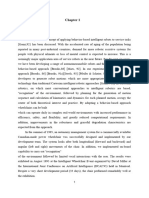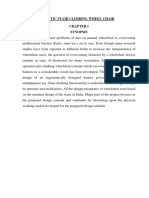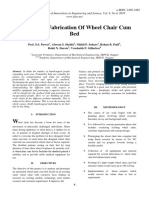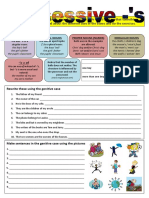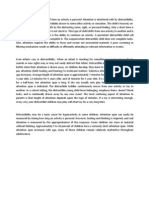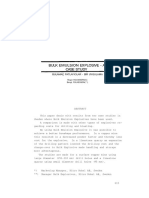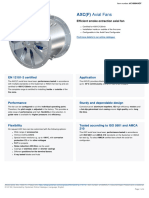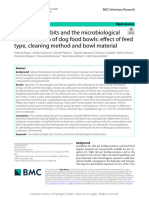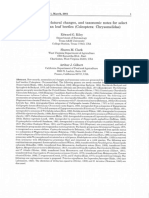Wheel Chair
Wheel Chair
Uploaded by
John CenaCopyright:
Available Formats
Wheel Chair
Wheel Chair
Uploaded by
John CenaOriginal Description:
Copyright
Available Formats
Share this document
Did you find this document useful?
Is this content inappropriate?
Copyright:
Available Formats
Wheel Chair
Wheel Chair
Uploaded by
John CenaCopyright:
Available Formats
Design of Multipurpose Wheel Chair for Physically
Challenged
1 2
and Elder People
3, 4
Mohan Kumar R. , Lohit H. S. , Manas Ranjan Mishra Md. Basheer Ahamed .
1-Student, M. Sc. [Engg.], 2- Asst. Prof., 3- Asst. Prof.
Department of Design, M. S. Ramaiah School of Advanced Studies, Bangalore 560058.
4- Technical Director, M/S Sidhi Vinayaka Fab Engineering Pvt. Ltd, Bangalore
Abstract
Wheel Chair is a mobility device designed for shifting patients, moving physically challenged people from one
place to another with the help of attendee or by means of self propelling. The wheel chair is divided into two different
types based on the power used for mobility: 1. Manually powered wheelchairs. 2. Electric powered wheelchairs. Manual
powered wheelchairs are driven by manual power which are again classified into foldable and non-foldable with or with
out commode design. Electrical powered wheel chairs runs with electric power however manual operation is required to
operate the joystick for the movement of the chair. The redesign of manual wheel chair was considered for this project.
The design of wheel chair started by means of literature review to know its evaluation from earlier to the
present generation. Market study was carried out to know the present competators available in the market with cost
analysis of the existing product. Ethnography study was done to observe the need, the importance of the existing product
and to address the design gap in the existing product to the user need through questionnaries. The feed back was taken
from different users and attendees, concept generation and design execution was done by the implementation of design
methodologies like Quality Function Deployment, Mind mapping, Product Design Specification.
The final output is a wheel chair which gives multiple option to the user and attendee by providing ease of
defecation, cleaning and changing of clothes. Adjustable back rest, arm rest, leg rest provides comfort for the patient
while resting. The adjustable arm rest provide ease of shifting the patient from chair to the bed or to the vehicle. Facility
provided for keeping plate while having food, reading and keeping water bottle. Additional to this alarm facility is
provided to inform the attendee that there is a need of his / her presence to the patient. Validation of the prototype is done
and usage is found satisfactory.
Key Words: Mobility Device, Wheel Chair, Ethnographic Research, QFD, PDS.
Abbreviations 1.3 Nomenclature of a Simple Rigid Frame
ID Industrial Design Wheel Chair
NPD New Product Design
PDS Product Design Specifications
QFD Quality Function Deployment
RSI Repetitive Strain Injuries
VOC Voice of Customer
1. INTRODUCTION
1.1 Product Design
Product design is the concept of systematic
approach in understanding the user requirement,
existing deficits, possible improvement and inventing
new designs through idea generation, concept
development, and concept realization thereby bringing Fig. 1 Nomenclature of a rigid frame wheel chair
newer products and solutions for the better quality of
life. 1.5 Need for New Design in a Wheel Chair
At present patients are facing problem while defecating.
1.2 Wheel Chair Patients needs to be lifted up and helped to remove the
A chair with wheels designed as a replacement for dress and make them defecate, which is discomforting
walking is known as wheel chair. This is used for to the patients in emergency condition. The design of
movement of physically disabled, elder people, children back rest in the existing wheel chair creates repetitive
who have difficulty and are unable to walk. This device stress injury if the patient is sitting for a long time. The
comes in many variations like self propelled, propelled present design of brake needs to be improved for better
by the motor or with the help of an attendee to push. impact and application of brake in slope area. Arm rest
Figure 1 & 2 shows the parts of rigid frame and X creates obstruction while shifting the patient from
frame wheel chair and its parts [1]. wheel chair to vehicles, no solution in the existing
design to make ease of shifting of patient to
transportation vehicle.
SAS TECH 107 Volume 11, Issue 1, Apr 2012
1.4 Nomenclature of a simple rigid frame wheel driven by the user by using the rear wheels (diameter of
chair 20-26) which resembles to that of bicycle but has an
additional rims know as hand rims are for the
movement of the chairs by means of pushing forward or
backward. The hand rims are of diameter lesser than the
rear wheels. Use of two hand rims at a time gives
straight movement of the chair, use of one of the rim
gives the turning movement to the chair towards left or
right [3].
Fig. 2 Nomenclature of a Foldable wheel chair
2. LITERATURE REVIEW
2.1 History and Evolution of Wheel chair
The first wheel chair was invented in the 1595
called as invalids chair was made for the king of Spain
Fig. 4 Bath chair by John Dawson and wheel chair
called Phillip. Later in the year 1655 Stephen Farfler
designed in 15th century
built a self-propelling chair on a three wheel chassis as
shown in figure 3 [1]. In the year 1783 John Dawson of
Bath Town England invented a wheel chair named as
bath wheel chair. The chair was with two large wheels
and one small one as shown in figure 4 [1]. In the year
1869 patent for a wheel chair with rear push wheels and
small front casters were invented, in the year 1881 the
push rims for self propulsion wheel chair was invented
as shown in figure 4 [1]. In 1900 the first spoked wheel
chair was invented and in the year 1916 first motorized
wheel chair was invented by British Engineers as shown
in figure 5 [1]. In the year 1932, Harry Jennings built
the first foldable wheel chair as shown in figure 5 [1]. Fig. 5 Wheel chair by an Indian and first foldable
wheel chair
Fig. 3 Wheel chair owned by King Philip II and self
propelled wheel chair Fig. 6 Different types of wheel chairs
2.2 Different Types of Wheel Chairs Attendant propelled wheel chairs (Figure 4) are
those wheel chairs which are known as transport
There are various types of wheel chairs, we are
wheelchairs that require attendees help for the
differentiating the wheel chair based on the mode of
movement. The wheel chair is designed such that there
power used for drive. These wheel chairs are is no big rear wheels with rim for the moving, moulded
differentiated in to two types as below [3]:
seating, light weight, push handles, support backrest,
Manual wheel chair hand brake system. These chairs are commonly seen in
Electric powered wheel chair airports to move passengers in to the seats [3]. Manual
2.3 Manual Wheel Chair wheel chair are again classified into two types as shown
in below (Figures 5 and 6) [3]
Manual wheel chairs are driven with the help of man o Rigid wheel chair
power as source of energy for moving the chair, these o Foldable wheel chair
are self propelled or propelled with the help of attendee
[2]. The self propelled wheel chairs (Figure 3) are
SAS TECH 108 Volume 11, Issue 1, Apr 2012
2.4 Electric Powered Wheel Chair
The wheel chair that runs by means of
Electric motor is known as electric-powered
wheelchair, this wheel chair requires navigational
controls, usually a small joystick mounted on the
armrest. For users who cannot manage a manual
joystick, head switches are provided and chin-operated
joysticks are provided, other specialist controls may
also be provided for independent operation of the
wheelchair. Motorized wheelchairs are useful for those
unable to propel manually or who require travelling for
a long distance which creates difficulty for manual
operation. These wheel chairs are not only used by Fig. 8 Applications of wheel chair
traditional mobility impairments but also by Figure 9 shows the some places where wheel chairs are
cardiovascular patients [3]. Different types of electric used in common.
and hydraulic power driven wheel chairs are as shown
in Figure 7 [13].
Fig. 9 Common places of wheel chair use
Fig. 7 Different types of motorised wheel chairs
2.5 Product Survey
Product survey is carried out to understand the
usability, functionality, need of the product, market
strategy, different class of users, where used, when used
and why used. With the help of Mind Mapping process
we can find out the usage of the product Mind Mapping
is carried out by process as listed below,
Fig. 10 Users of wheel chair
Why Used
Where and who are the Users 2.5.3 When Used
When Used During Emergency like:
Different types of wheel chair o Road Accidents
available in Indian market o Fire Accidents
2.5.1 Why Used o Air Accidents
o Maternity emergency
Wheel chairs are used to shift the patients from o Physical disorders
one ward to another in hospitals and from one room to
another at home, as a walker for the people who are In day to day life by:
unable to walk. Figure 8 shows few situations where o Physically challenged people
wheel chairs are used. o Old people unable to walk
o Physically challenged children
2.5.2 Different Applications of Wheel Chair
2.6 Market Study
o In Hospitals, Nursing homes
o In Houses Market study is done to understand the product market
o In Pilgrim places segment, to know the competitors in the market, to
o In Travelling study their product capacitance and market strategy, to
o In Sports bench mark the product. Following are some of the
o In Beaches competitors present in the Indian market:
i. M. TECHNOLOGIES Manufacturer of
Hospital Equipments, Hospital Supplies,
Hospital Furniture, Medical Furniture,
Hospital Beds, Hospital Trolley, Wheelchairs,
SAS TECH 109 Volume 11, Issue 1, Apr 2012
Bunk Beds, Office Furniture, MDF Furniture,
Hospital Blankets and Garments Haryana.
ii. ANAND MEDICAL EXPORTS
Manufacturer, Trading Company of Hospital
products New Delhi.
iii. SAYANI SURGICALS Manufacturer,
Trading Company, Distributor/Wholesaler of
Physiotherapy, Rehabilitation, Orthopaedic
application, Walking Aids, Wheel chair,
Gym, Obesity, Health Care, Hospital
Furniture, Surgical Instruments.
iv. PARAMOUNT SURGIMED LTD Fig. 12 Identification of problem 2
Manufacturer of Hospital Equipments,
Surgical blades, Wheelchairs, Surgical 3. Shortage of the height of the back rest, no
Gloves, Walking Stick, Hot water bottle, adjustable and cushioned back rest, no head
Walkers New Delhi. rest in the existing design, identified problem
v. VISSCO INDUSTRIES Manufacturer, is as shown in Figure 13.
Trading Company of Hospital Furniture's and
Wheel chairs Pune.
vi. MANISH STEEL INDUSTRIES
Manufacturer, Trading company of Hospital
products like Wheelchairs, Tricycle, Walker,
Hearing Aid, Crutches, Sticks, Folding
Commode, Cycle Rickshaw, Handicap
Moped Madhya Pradesh.
2.6 Problems Identified in the Present Wheel
Chair
Gemba study shows that the two main types
of wheel chairs used in hospitals and houses are rigid
frame wheel chair and foldable X frame wheel chair
with and without commode design. Problems identified Fig. 13 Identification of problem 3
are as listed below: 4. Observation shows problem in defecation
1. Observation shows that there is no adjustable shifting of patient to the commode in case of
arm rest, knee rest and foot rest the identified non commode wheel chair, removing and
problem is as shown in Figure 11. cleaning problem in case of existing
commode wheel chair, identified problem is
as shown in Figure 14.
Fig. 11 Identification of problem 1
2. Observation shows that there is difficulty in Fig. 14 Identification of problem 4
shifting the patient from wheel chair to auto
rickshaw and other vehicles due to bad 5. Observation shows that problem in reaching
braking system provided identified problem is the table and non adjustable height of table
as shown in Figure 12. for ease of work which increases repetitive
stress injuries like wrist, back, shoulder
injuries; identified problem is as shown in
Figure 15.
SAS TECH 110 Volume 11, Issue 1, Apr 2012
3.2 Human Dimensions for Wheel Chair Design
These figures are at a median value between the 95th
percentile male (largest) and 50th percentile female
(smallest).
Fig. 15 Identification of problem 5
Fig. 16 Human dimensions
2.7 Advantages of Rigid Frame Wheel Chair The seat is the part which takes plays very important
Low cost, Easily affordable role in a wheel chair. So that maximum of concentration
Low maintenance cost as the parts are made is given to the seat design to achieve the best
of aluminum alloy. comfortableness in any wheel chair.
Heavy weights can be accommodated.
Less weight
2.8 Disadvantages of Rigid Frame Wheel Chair
Non foldable, requires more space.
Non adjustable back and arm rest
No stopper for backward moment
Non adjustable food rest Fig. 17 Mid thigh-thigh distance
2.9 Advantages of X Frame Wheel Chair
Foldable accommodates less space
Ease of transportation as it requires less space
Cushioned back rest and adjustable foot rest
Commode design for defecating
2.10 Disadvantages of X Frame Wheel Chair
Cause repetitive stress injury due to flexible
back rest
Heavier in weight as it is made of stainless
steel body
Less durable as it comes in contact with
environmental disorders
Maintenance cost is more Fig. 18 Human leg folding dimension
Attendees face problem in cleaning the
patient after defecation
3. HUMAN DIMENSION AND ERGONOMIC
STUDY
Ergonomics is the scientific discipline concerned to
understand the interaction between human beings and
elements of the system where he is living. Ergonomics
is employed in fulfilling the goals of health and
productivity
3.1 Ergonomics with Wheel Chair Users
Study of ergonomics of the wheel chair is the
interaction in relation to aspects of vehicle mechanics
and the user's physical condition. Ergonomically
designed wheel chair will reduce the strain that is
caused due to longer use of the product [11].
Ergonomics in wheel chair considers four key criteria Fig. 19 Dimensions for hand grip design
like force, repetition, duration, posture.
SAS TECH 111 Volume 11, Issue 1, Apr 2012
Fig. 20 Dimensions for frame design
This thumb rule is used for both designing the seat for
Table 1. Quality Functional Deployment
both male female, this standard is mainly used for
determining the dimensions of a seat. In this standard it
is explained that 95th percentile for male and female are
found to be 449 to 529mm respectively and combined
95th percentile value i.e. 479mm for general purpose
seat design [11].
4. CONCEPT GENERATION
4.1 PDS and QFD
Based on the Gemba study, data analysis and
questionnaires, the below list briefly illustrates essence
of customer voice.
Table 2. Product Design Specification
4.4 Concept 1
Concept 1 was generated with the PDS structure
implemented on the basic design of wheel chair. The
design was developed as a combined solution in a basic
wheel chair model with commode design for ease of
defecation for the patients and elder people. Sliding arm
rest was provided for the ease of shifting the patient
from chair to the bed or to the vehicle, cushioned foot
rest for the cushioning feel to the foot. A good
improved brake system provided to stop the wheel chair
when moving down stairs in inclined angle. Figure 22
shows the wheel chair with foldable x frame design,
cushioned seat with head rest that allows the patients to
rest the head and back comfortably (Neck injured,
back injured, stomach operated, shoulder injured
people). The opening of the commode is provided at the
front portion of the wheel chair so that the patient can
open the commode before defecating and close after the
defecating. Water tank with flush gun provided for ease
of cleaning after defecation. The back rest, commode
seat can be dismantled and the chair can be folded
which helps in ease of transportation. Additional
features like support plate for keeping plates while
Fig. 21 Quality Functional Deployment having food, keep books & laptop in case of student
using the wheel chair, bell provided for indication of
help required by the patient at the time of attendee away
from him.
SAS TECH 112 Volume 11, Issue 1, Apr 2012
Sliding arm rest was provided to provide comfort to the
arm while resting and for the ease of shifting the patient
from chair to the bed or to the vehicle. A good
improved brake system provided to stop the wheel chair
when moving down stairs in inclined angle. Figure 23
shows the wheel chair with foldable x frame
design, cushioned seat with head rest that allows the
patients to rest the head and back comfortably (Neck
injured, back injured, stomach operated, shoulder
injured people). The commode is provided with hinge
type swinging opening and closing system, commode
opening is provided at the back side of the wheel chair.
Cushioned leg rest to provide cushioning effect for the
leg injured patients, adjustable backrest and leg rest
with screw lock system with angular rotating design as
shown in figure 4.2 provided for rotating the seat and
leg rest to inclined angle (from 90 to 180) as required
by the patient while resting. Water tank with flush gun
provided for ease of cleaning after defecation. The back
rest, commode seat can be dismantled and the chair can
be folded which helps in ease of transportation.
Additional features like support plate for keeping plates
while having food, keep books & laptop in case of
student using the wheel chair, bell provided for
indication of help required by the patient at the time of
attendee away from him.
Fig. 22 Concept 1 4.6 Concept 3
4.5 Concept 2 Concept 3 was generated with the help of PDS structure
implemented on the design of wheel chair. The design
With the help of the PDS structure Concept 2 of wheel was developed with improved commode design for ease
chair was generated. The design was developed with of defecation for the patients and elder people.
improved commode design for ease of defecation for Swinging arm rest as shown in figure 4.3 was provided
the patients and elder people. to provide comfort for the patient while resting the arms
and for the ease of shifting the patient from chair to the
bed or to the vehicle, the arm rest can be rotated to
comfortable angle as per the patient requirement. A
good improved brake system provided to stop the wheel
chair when moving down stairs in inclined angle.
Figure 4.3 shows the wheel chair with foldable x frame
design, cushioned seat with head rest that allows the
patients to rest the head and back comfortably (Neck
injured, back injured, stomach operated, shoulder
injured people). The commode is provided with hinge
type swinging opening and closing system, commode
opens towards side similar to the windows in houses.
Cushioned leg rest to provide cushioning effect for the
leg injured patients, adjustable backrest and leg rest
with spring operated lock system with angular rotating
design as shown in figure 4.3 provided for rotating
the seat and leg rest to inclined angle (from 90 to
180) as required by the patient while resting. Water
tank with flush gun provided for ease of cleaning after
defecation. The back rest, commode seat can be
dismantled and the chair can be folded which helps in
ease of transportation. Additional features like support
plate for keeping plates while having food, keep books
& laptop in case of student using the wheel chair, bell
provided for indication of help required by the patient at
the time of attendee away from him.
Fig. 23 Concept 2
SAS TECH 113 Volume 11, Issue 1, Apr 2012
comfort for the arms while resting by sliding to the arm
rest to comfortable height & for the ease of shifting the
patient from chair to the bed or to the vehicle. Deign is
provided with a good improved brake system provided
to stop the wheel chair when moving down stairs in
inclined angle. Figure 25 shows the wheel chair with
foldable x frame design, cushioned seat with head rest
that allows the patients to rest the head and back
comfortably (Neck injured, back injured, stomach
operated, shoulder injured people). The commode is
provided with hinge type swinging opening and closing
system, commode opens towards back side of the wheel
chair. Cushioned rotatable leg rest to provide
cushioning effect for the leg injured patients, adjustable
backrest and leg rest with spring operated lock system
with angular rotating design as shown in figure 25
provided for rotating the seat and leg rest to inclined
angle (from 90 to 180) as required by the patient
while resting. Water tank with flush gun provided for
ease of cleaning after defecation. The back rest,
commode seat can be dismantled and the chair can be
folded which helps in ease of transportation. Additional
features like support plate for keeping plates while
having food, keep books & laptop in case of student
using the wheel chair, bell provided for indication of
help required by the patient at the time of attendee away
from him.
Fig. 24 Concept 3 4.8 Concept 5
4.7 Concept 4
Fig. 26 Concept 5
Concept 5 was generated with the help of the PDS
structure implemented on the design of wheel chair.
Fig. 25 Concept 4 The design was developed with improved commode
design for ease of defecation for the patients and elder
Concept 4 was generated with the help of the PDS
people. Rotatable arm rest was provided to increase the
structure implemented on the design of wheel chair.
comfort for the arms while resting by rotating the arm
The design was developed with improved commode
rest to comfortable angle and for the ease of shifting the
design for ease of defecation for the patients and elder
patient from chair to the bed or to the vehicle. Design is
people. Sliding arm rest was provided to increase the
SAS TECH 114 Volume 11, Issue 1, Apr 2012
provided with a good improved brake system provided 5.3 Selected Concept
to stop the wheel chair when moving down stairs in
inclined angle. Figure 26 shows the wheel chair with
foldable x frame design, cushioned seat with head rest
that allows the patients to rest the head and back
comfortably (Neck injured, back injured, stomach
operated, shoulder injured people). Open commode
with bottom cover plate for opening and closing is
provided. Cushioned rotatable leg rest to provide
cushioning effect for the leg injured patients, adjustable
backrest and leg rest with spring operated lock system
with sliding design as shown in figure 26 provided
for rotating the seat and leg rest to inclined angle (from
90 to 180) as required by the patient while resting.
Water tank with flush gun provided for ease of cleaning
after defecation. The back rest, commode seat can be
Figure 27 Final concept
dismantled and the chair can be folded which helps in
ease of transportation. Additional features like support
plate for keeping plates while having food, keep books 5.4 Working Model
& laptop in case of student using the wheel chair, bell After selecting the final design, mock up model is
provided for indication of help required by the patient at prepared to get the touch and feel of the actual product.
the time of attendee away from him. In consultation with the study following specs are
finalised;
5 CONCEPT SELECTION, FINALIZING Material
AND MODEL MAKING Frame 25mm x 1mm thick hallow pipe of
stainless steel 304
5.1 Concept Selection Body 1 mm thick Stain less steel 304 sheet
After the generation of concepts, the sketching and Wheel rim 304 stainless steel
rendered images of different types along with depiction Tyre hard nylon rubber
to understand the working principles were prepared. A Seat & Back rest cushioned foam seat
total of 5 concepts were generated. These were Brake mechanical operated disc brake
explained to various people in the community. Based on Commode rigid plastic
the explanation and their understanding of the concept Scale
through these images, various feedbacks were collected 1: 1 for working prototype
from them. The feedbacks were analyzed and 1:3 for Mockup model
categorized according to design parameters through Place of execution
which the pros and cons of each concept were studied M/S Sidhi Vinayaka Fab Engineering Pvt. Ltd.,
and the best concept for chosen for this study by PUGH Bangalore
method. Finish
External surfaces glossy finish & internal surfaces
5.2 PUGH Method polished to Smooth curvature
Using the PUGH method, concepts are analyzed for Color
various parameters of each model against the fixed Stainless steel frame, foam cushioned seat, disc
rating for each parameter, its pluses and minuses in braking system, plastic commode seat frame, rigid
terms of its usability, performance, unique features, etc nylon tyres.
are counted. Based on the overall rating, concept # 5 is Accessories
selected as final trolley design. Water gun with hose for flushing
5.6 Working Model Preparation Process
After finalizing the pre requisites for model preparation
using cad drawings following activities has been done
to complete the final model
1. Procurement of Raw materials.
2. Raw material marking & cutting
3. Removing of burr, Stitch welding to built
chassis assy
4. Preparation of development drawings of the
outer body
5. Laser cutting , shearing & bending
6. Tack & Full welding
Table 3 Pugh chart 7. Grinding & polishing
8. Final buffing
9. Acid pickling & Cleaning
10. Cushioning Seat
11. Assembling of seat, flush gun, rest plate
SAS TECH 115 Volume 11, Issue 1, Apr 2012
Figure 28 shows the cutting of raw material in the Figure 5.6 shows the water tank, flush gun, disc brake,
working space. alarm system with battery and alarm plug provided in
the final finished wheel chair.
Fig. 28 Raw material cutting model making
Fig. 32 Rear view of the finished model
Figure 29 shows the tack welding and full welding of
joints in the frame. 6 CONCEPT VALIDATION
6.1 Validation
Validation is done to know whether the designed
product according to the specification is successful or
not. Validation is obtained by doing feasibility test,
usability test and desirability test. The final design
product was subjected to feasibility, usability and
desirability with different patients and feedback was
taken in the form of documentation, pictures and
videos. The model was tested with the patients in
Fig. 29 Outer body welding during model making Peenya 2nd stage, and different patients in M. S.
Figure 5.4 shows the semi finished product in the shop Ramaiah Hospital.
floor. The figure shows different patient using the working
model. Figure 33 shows the patient who is using the
wheel chair in the house from many years, the feedback
was taken based on the performance of our product and
the previous product which was used by them in their
house.
Fig. 30 Semi finished final model Fig. 33 Validation from user at home
Figure 5.5 shows the complete assembled product and The wheel chair was taken to the hospital and feedback
inclined product to 0 back rest and leg rest was taken from different user Figure 6.2 shows the
. patient who is using the wheel chair in the hospital. The
patient and attendee was allowed to use the wheel chair
at the end of the day the feedback was taken from the
patient and the attendee by means of pictures and
videos suggestion was taken for the improvements in
the existing product.
Feedback was taken from the Chief Administrator,
Administrator, Doctors, Nurses and Attendees. The
feedback was collected verbally and through video. The
collected data was accumulated and incorporated as
future work.
Fig. 31 Final finished model
SAS TECH 116 Volume 11, Issue 1, Apr 2012
8. REFERENCES
[1] Batavia, M., PH. D (1998), The wheel chair
evaluation a practical guide, ISBN 0-7506-
7037-1
[2] Croteau, C. (1998), Wheel chair mobility hand
book, Park press publishing
[3] Cooper, R. A., PH.D. (1998) Wheel chair
selection and Configuration, Demos Medical
Fig. 34 Validation from user at hospital Publishing Inc
The above methodology was adopted to generate the [4] Bechtel, R., Certified Rehabilitation Technology
new concept which is believed to provide good
performance, usability, economic and good in aesthetic Supplier: University of Michigan Health Systems
when compared to the existing models in the market. Wheelchair Seating Services. (734) 971-8286
The combination of unique feature in a single system
will be a successful and will help to sell this product in [5] Chitale, A. C., Gupta, R. C. (2002), Product
the market. The response obtained by the users and design and manufacturing, Prentice-hall
attendees was good, there is full hope that this design
will going to be a real time. The product was sponsored [6] Lal, G. K., Vijay Gupta (2010), Fundamentals
and fabricated in M/S Sidhi Vinayaka Fab Engineering of design and manufacturing, Narosa Book
Pvt. Ltd., it is an ISO certified company in
manufacturing of stainless steel sheet metal fabrication [7] Chakrobarti, D. (1997), Indian Anthropometric
in Bangalore. The difference between the existing dimensions for Ergonomic design Practice,
product and the concept generated product is shown in
table 4. National Institute of Design,
[8] McCombs, K. (2002), Material hand book,
McGraw-Hill
[9] Vaccari, J. A.(2002), Material hand book,
McGraw-Hill
[10] Ulrich. K. (1995), Product Design &
Development, Mc Graw Hill Company
[11] Anonymous. (Dated 20-05-2011), http:
//en.wikipedia.org/wiki/Wheelchair
[12] Anonymous. (Dated 20-05-2011), http
://en.wikipedia.org /wiki / Manual Wheelchair
[13] Anonymous. (Dated 20-05-2011), http:
//www.amazon.com/Wheelchair-book-mobility-
disabled
[14] Anonymous. (Dated 20-05-2011), http:
Table 4 Comparison of existing model with new
//en.wikipedia.org/wiki/Ergonomics
design
[15] Anonymous. (Dated 20-05-2011),http:
7. CONCLUSIONS
//www.indiamedico.com / rehabilitation
The knowledge gained from product design education is
used to analyse the existing wheel chair product by _aids_products
means of detailed Market research, GEMBA study, [16] Anonymous.(Dated20-05-2011), http://
product study, problem identification, concept
generation, concept finalization, detailing, and mock up www.globalsources.com/manufacturers/
modeling of the finalised concept. Validation of the Wheelchair.html
prototype is done and usage is found satisfactory.
[17] Anonymous. (Dated 21-05-2011), http://
www.tradeindia.com/manufacturers
/indianmanufacturers/Wheelchair.html
SAS TECH 117 Volume 11, Issue 1, Apr 2012
You might also like
- Final Report FinalisedDocument46 pagesFinal Report Finalisedvijay.abeegroupNo ratings yet
- Stair Climbing Wheel ChairDocument34 pagesStair Climbing Wheel ChairBoopathi KalaiNo ratings yet
- 8.motorized Wheel ChairDocument55 pages8.motorized Wheel ChairWORLD360No ratings yet
- Project MechaDocument19 pagesProject MechaBirhanu AsfawNo ratings yet
- Literature Review Main PointsDocument4 pagesLiterature Review Main Pointsitezaz ahmedNo ratings yet
- Design and Development of Conceptual Whe PDFDocument9 pagesDesign and Development of Conceptual Whe PDFKumar SonuNo ratings yet
- IJSARTV2I3847Document6 pagesIJSARTV2I3847s2002hadiNo ratings yet
- Akhil C, Muhammed Irfan, Muhammed Shabeeb, Rabeeh Rahman M, Mohammed SameelDocument14 pagesAkhil C, Muhammed Irfan, Muhammed Shabeeb, Rabeeh Rahman M, Mohammed Sameelmiakajemal22No ratings yet
- Wheelchair FolderDocument30 pagesWheelchair FolderSyafiq Fauzi100% (1)
- Technical ReportDocument19 pagesTechnical Reportvishnu vishnu G.T.No ratings yet
- Mechanically Operated Wheelchair Convertible Stretcher and Walker Ijariie6974Document6 pagesMechanically Operated Wheelchair Convertible Stretcher and Walker Ijariie6974Ravi Kanth Yadav100% (1)
- Design and Fabrication of Tricycle For Physically Challenged and Elder PeopleDocument6 pagesDesign and Fabrication of Tricycle For Physically Challenged and Elder Peopleदेवेश सिंह राजपूतNo ratings yet
- Handicapped Steering Cycle Project ReportDocument51 pagesHandicapped Steering Cycle Project ReportErole Technologies Pvt ltd Homemade EngineerNo ratings yet
- Proposal Wheelchair EMD4M7BDocument29 pagesProposal Wheelchair EMD4M7BSyafiq FauziNo ratings yet
- Ijreiss 4094 95410Document13 pagesIjreiss 4094 95410ivs yeswanthNo ratings yet
- Wheelchair Cum Stretcher IJERTV6IS100039 PDFDocument5 pagesWheelchair Cum Stretcher IJERTV6IS100039 PDFsinganamala son'sNo ratings yet
- Wheel Chair Cum StrecherDocument9 pagesWheel Chair Cum StrecherSendhilNathanNo ratings yet
- Chapter 5Document8 pagesChapter 5almuhajiribnusabilNo ratings yet
- Wheelchair Cum Stretcher FinalDocument27 pagesWheelchair Cum Stretcher FinalTHESRIFNo ratings yet
- Design of Advanced Multi Desire Wheel-ChairDocument12 pagesDesign of Advanced Multi Desire Wheel-ChairKaah LukasNo ratings yet
- Design and Fabrication of Wheelchair Cum Stretcher IJERTV11IS080059Document6 pagesDesign and Fabrication of Wheelchair Cum Stretcher IJERTV11IS080059Aadarsh tripathiNo ratings yet
- Design and Fabrication of Wheelchair Cum Stretcher With Multi FoldDocument9 pagesDesign and Fabrication of Wheelchair Cum Stretcher With Multi FoldYogesh E Hegade100% (1)
- BIT766ijarseDocument6 pagesBIT766ijarsemiakajemal22No ratings yet
- PT 224 Wheelchair Management 2Document30 pagesPT 224 Wheelchair Management 2tumaini matandalaNo ratings yet
- Caregiving 4 Assistive DevicesDocument51 pagesCaregiving 4 Assistive DevicessvtperjesNo ratings yet
- Kneeling ChairDocument2 pagesKneeling ChairPiyush AroraNo ratings yet
- JETIR1802057Document14 pagesJETIR1802057ss6381830413No ratings yet
- Design and Simulation of An Automated WH PDFDocument6 pagesDesign and Simulation of An Automated WH PDFta21rahNo ratings yet
- Ss Tenrofessor of Mechanical E Ineering: 1 SlibrariesDocument0 pagesSs Tenrofessor of Mechanical E Ineering: 1 SlibrariesPrateek AggarwalNo ratings yet
- Major Project Report FinalDocument33 pagesMajor Project Report FinalBrowsingMemoriesNo ratings yet
- Mechanically Operated Wheelchair Convertible StretcherDocument5 pagesMechanically Operated Wheelchair Convertible StretcherIAEME PublicationNo ratings yet
- For MamtDocument72 pagesFor Mamt. Phone Myat ZawNo ratings yet
- New Low-Cost Design of Staircase Climbing Wheelchair'Document7 pagesNew Low-Cost Design of Staircase Climbing Wheelchair'kaushik_ranjan_2No ratings yet
- Design and Fabrication of Lever Propelled WheelchairDocument6 pagesDesign and Fabrication of Lever Propelled WheelchairAnonymous kw8Yrp0R5rNo ratings yet
- Design and Analysis of Wheelchair For Usage of Handicap PeopleDocument32 pagesDesign and Analysis of Wheelchair For Usage of Handicap PeopleJesus Arcia HdzNo ratings yet
- MECH 420 Final ReportDocument35 pagesMECH 420 Final Reportpp9p2m5x5gNo ratings yet
- Convertible StretcherDocument4 pagesConvertible StretcherJournalNX - a Multidisciplinary Peer Reviewed JournalNo ratings yet
- Design and Fabrication of Multi-Purpose Wheelchair For Disabled PersonDocument5 pagesDesign and Fabrication of Multi-Purpose Wheelchair For Disabled PersonRahul kundiyaNo ratings yet
- Project Synopsis PDFDocument5 pagesProject Synopsis PDFRahul kundiyaNo ratings yet
- User Centric Design PDFDocument40 pagesUser Centric Design PDFRitik YadavNo ratings yet
- Review of Motorized Tricycle For The Disabled PersonDocument5 pagesReview of Motorized Tricycle For The Disabled PersonsanjuNo ratings yet
- 4Document2 pages4raaz987096No ratings yet
- All-Terrain Wheelchair Increasing Personal Mobility With A Powered Wheel-Track Hybrid WheelchairDocument11 pagesAll-Terrain Wheelchair Increasing Personal Mobility With A Powered Wheel-Track Hybrid WheelchairKaah LukasNo ratings yet
- Flexible WheelDocument8 pagesFlexible WheelSatish MudalagiNo ratings yet
- Report Wheel Chair Cum StretcherDocument42 pagesReport Wheel Chair Cum StretcherTanvi KhuranaNo ratings yet
- A Study Work On Design and Development of Hubless CycleDocument4 pagesA Study Work On Design and Development of Hubless Cycle045 Haritha A S Mech ANo ratings yet
- Coolers Concept of KalidoscopeDocument28 pagesCoolers Concept of KalidoscopealziyaNo ratings yet
- Design and Fabrication of Wheel Chair Cum BedDocument4 pagesDesign and Fabrication of Wheel Chair Cum BedDevang RathoreNo ratings yet
- Design of Hand Gesture Control Wheel ChairDocument5 pagesDesign of Hand Gesture Control Wheel ChairInternational Journal of Innovative Science and Research TechnologyNo ratings yet
- Portable Recliner-Final PaperDocument25 pagesPortable Recliner-Final PaperShivendra pratap singhNo ratings yet
- User Assessment of Manual Wheelchair Ride Comfort and ErgonomicsDocument5 pagesUser Assessment of Manual Wheelchair Ride Comfort and Ergonomicsosama taisirNo ratings yet
- Design and Fabrication WHEEL CHAIRDocument12 pagesDesign and Fabrication WHEEL CHAIRsachinjambuNo ratings yet
- IJRPR23502Document4 pagesIJRPR23502Dharmaraj kisan KharpadeNo ratings yet
- Fabrication of Collapsible Chair Cum Bed Model An Engineering ApproachDocument5 pagesFabrication of Collapsible Chair Cum Bed Model An Engineering Approachs2002hadiNo ratings yet
- Treadmill BicycleDocument4 pagesTreadmill BicycleAnonymous kw8Yrp0R5rNo ratings yet
- Project 3rd1 PDFDocument50 pagesProject 3rd1 PDFAbdul RaqeebNo ratings yet
- The Motor Biker's Dictionary: Specialized Driver Training Series, #0From EverandThe Motor Biker's Dictionary: Specialized Driver Training Series, #0No ratings yet
- Lucky LukeDocument8 pagesLucky LukejeyabalanmaduraiNo ratings yet
- Possessive SDocument1 pagePossessive SSueRamiro-IbanezNo ratings yet
- Attention SpanDocument1 pageAttention SpanOliver MacaraegNo ratings yet
- Monthly HSE PerformanceReport REV2Document2 pagesMonthly HSE PerformanceReport REV2parthaNo ratings yet
- Avoiding Adverse Drug InteractionsDocument2 pagesAvoiding Adverse Drug InteractionselaboratesolverNo ratings yet
- Mindset Level 1-Activity BookDocument226 pagesMindset Level 1-Activity Bookchuduc ducchu100% (1)
- Bulk Emulsion Explosive - A Case Study: Bulamaç Patlayicilar - Bir UygulamaDocument16 pagesBulk Emulsion Explosive - A Case Study: Bulamaç Patlayicilar - Bir Uygulamalonelystar19100% (1)
- ResumeDocument4 pagesResumeMaressa MalabananNo ratings yet
- Đề Thi Giữa HK1.Anh 7 2022-2023Document2 pagesĐề Thi Giữa HK1.Anh 7 2022-2023bao phamvanNo ratings yet
- Family Life CycleDocument57 pagesFamily Life CycleJardee DatsimaNo ratings yet
- Resume Erica Marie Skrip 2017Document3 pagesResume Erica Marie Skrip 2017api-354346726No ratings yet
- Utilization of Brine Sludge in Non-Traffic Paver Blocks: by Gaurav PathakDocument21 pagesUtilization of Brine Sludge in Non-Traffic Paver Blocks: by Gaurav PathakgauravNo ratings yet
- Stress in SpeechDocument1 pageStress in Speechsamz Khaizer001No ratings yet
- Systemair AXC 1000 (F)Document4 pagesSystemair AXC 1000 (F)tigoxoh676No ratings yet
- Cellular Transport WORKSHEETDocument2 pagesCellular Transport WORKSHEETDr-Qussai ZuriegatNo ratings yet
- CIBSE Lighting Guide LG3-Visual Environment For Display Screen UseDocument84 pagesCIBSE Lighting Guide LG3-Visual Environment For Display Screen UseANJINo ratings yet
- Technical Information Liquiline CM442R/CM444R/ CM448RDocument56 pagesTechnical Information Liquiline CM442R/CM444R/ CM448Rkythuat04 nteNo ratings yet
- Pet Feeding Habits and The Microbiological Contamination of Dog Food Bowls Effect of Feed Type, Cleaning Method and Bowl MateriaDocument12 pagesPet Feeding Habits and The Microbiological Contamination of Dog Food Bowls Effect of Feed Type, Cleaning Method and Bowl MateriaDesislava DenkovaNo ratings yet
- PBT1500 Data SheetDocument3 pagesPBT1500 Data Sheetorlando durandNo ratings yet
- Validation ReqsDocument11 pagesValidation ReqsBabbooNo ratings yet
- New Records, Nomenclatural Changes, and Taxonomic Notes For Select North American Leaf Beetles (Coleoptera: Chrysomelidae)Document17 pagesNew Records, Nomenclatural Changes, and Taxonomic Notes For Select North American Leaf Beetles (Coleoptera: Chrysomelidae)Rosa Quezada DanielNo ratings yet
- IVF SolutionsDocument22 pagesIVF SolutionsFatima CorpuzNo ratings yet
- Beginner's Guide To Vintage Singer Sewing Machine RefurbishmentDocument59 pagesBeginner's Guide To Vintage Singer Sewing Machine RefurbishmentStephen ValentineNo ratings yet
- Types of Menu PDFDocument4 pagesTypes of Menu PDFSofía88% (8)
- Special EducationDocument4 pagesSpecial EducationArgie Cayabyab CagunotNo ratings yet
- Chapter 7 - New Products: Knowledge ObjectivesDocument11 pagesChapter 7 - New Products: Knowledge ObjectivesJenmark JacolbeNo ratings yet
- To My Future SelfDocument2 pagesTo My Future SelfShy PaguiganNo ratings yet
- PPE KITS PHYSICS NewDocument19 pagesPPE KITS PHYSICS NewSushant MNo ratings yet
- International Rice Research Notes Vol.29 No.1Document85 pagesInternational Rice Research Notes Vol.29 No.1ccquintos100% (1)
- Ceb Let Eng0317Document46 pagesCeb Let Eng0317PRC Board50% (2)
